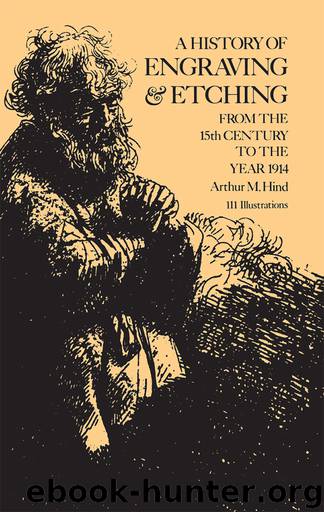A History of Engraving and Etching by Arthur M. Hind

Author:Arthur M. Hind
Language: eng
Format: epub
Publisher: Dover Publications
Published: 1963-03-13T05:00:00+00:00
FIG. 90.—Andrew Geddes. Portrait of his Mother.
He made the drawings26 for the most part in sepia,27 etched the main outlines in vigorous line,28 and then put the plate in the hands of some mezzotint engraver to finish the subject by the aid of his drawing and under his supervision.
Turner originally intended to include 100 plates in the work, but only 71 were published,29 some 20 more plates being engraved or partially finished. F. C. LEWIS finished the first plate (R. 43) in aquatint, but this was his only plate, and Turner inclined thenceforward to the use of mezzotint, though aquatint is not infrequently found in combination. The other engravers who contributed were CHARLES TURNER (23 published plates, 1 unpublished), W. SAY (11 published, 2 unpublished), DUNKARTON (5 published plates), G. CLINT (2 published plates), J. C. EASLING (frontispiece, 3 plates alone, and 1 in collaboration with Annis), W. T. ANNIS (1 alone), S. W. REYNOLDS (2 published plates), T. HODGETTS (3 published plates), H. DAWE (4 published, and possibly several of the unpublished plates), T. LUPTON30 (4 published, and 2 unpublished plates), and finally 10 of the published plates and some of the unpublished were mezzotinted by J. M. W. Turner himself.
One of the most powerful of the plates entirely done by Turner, the Junction of the Severn and the Wye (R. 28) is reproduced in its early etched state (showing signs of the mezzotint rocker in places) in Fig. 91. In three instances the etching was done in soft ground, i.e. R. 70, 90, and 91, the two latter not being carried beyond this stage. The Liber was issued in fourteen parts (each containing five plates) between 1807 and 1819, but was then relinquished for lack of success. Some of the drawings, which were not reproduced at the time, have been recently engraved with no less power than is seen in the best of those by Turner’s contemporaries, by FRANK SHORT. Mr. Short has also made copies of some of the plates, a considerable number being after those which were left unpublished in 1819. It may be added that another of the drawings (Mill near the Grande Chartreuse, R. 54) was twice etched by SEYMOUR HADEN (Drake 49 and 50).
The reworking of the plates as they became worn in the printing seems to have been done entirely by Turner himself, and the later impressions preserve a comparatively greater artistic value than they would do in the ordinary course, on that account. It is still, however, the early engraver’s proofs, and only the earliest of the published states,31 which show the delicate mezzotint burr in all its richness.
Download
This site does not store any files on its server. We only index and link to content provided by other sites. Please contact the content providers to delete copyright contents if any and email us, we'll remove relevant links or contents immediately.
Wonder by R.J. Palacio(8432)
Mastering Adobe Animate 2023 - Third Edition by Joseph Labrecque(3722)
Unlabel: Selling You Without Selling Out by Marc Ecko(3575)
Ogilvy on Advertising by David Ogilvy(3486)
Hidden Persuasion: 33 psychological influence techniques in advertising by Marc Andrews & Matthijs van Leeuwen & Rick van Baaren(3456)
Drawing Cutting Edge Anatomy by Christopher Hart(3440)
The Pixar Touch by David A. Price(3349)
POP by Steven Heller(3298)
The Code Book by Simon Singh(3058)
The Art of War Visualized by Jessica Hagy(2932)
Slugfest by Reed Tucker(2924)
The Curated Closet by Anuschka Rees(2899)
Rapid Viz: A New Method for the Rapid Visualization of Ideas by Kurt Hanks & Larry Belliston(2816)
Stacked Decks by The Rotenberg Collection(2796)
365 Days of Wonder by R.J. Palacio(2739)
The Wardrobe Wakeup by Lois Joy Johnson(2720)
Keep Going by Austin Kleon(2683)
Tattoo Art by Doralba Picerno(2585)
Tell Me More by Kelly Corrigan(2579)
